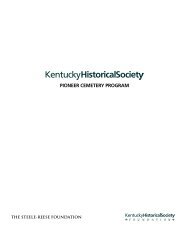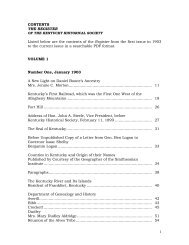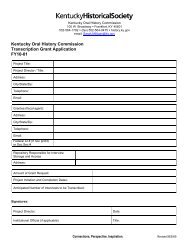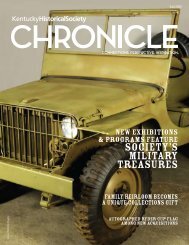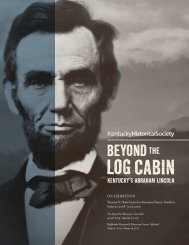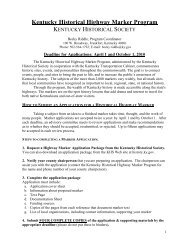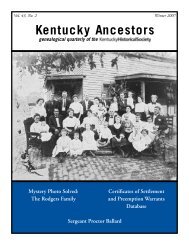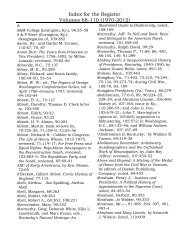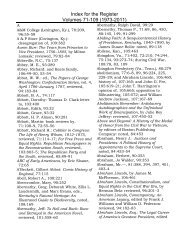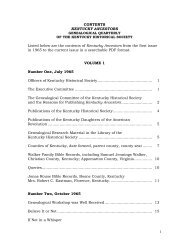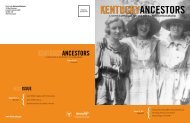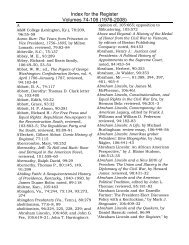kentucky decorative arts treasures - Kentucky Historical Society
kentucky decorative arts treasures - Kentucky Historical Society
kentucky decorative arts treasures - Kentucky Historical Society
Create successful ePaper yourself
Turn your PDF publications into a flip-book with our unique Google optimized e-Paper software.
landscape backgrounds lit with warmth and drama, an<br />
expression we can call the romantic sublime. William<br />
Walcutt’s painting of Simon Kenton was based on<br />
the old pioneer’s account of being captured by Native<br />
Americans in 1778. According to Kenton, these Native<br />
Americans “brought up a wild, unbroken colt . . . to<br />
which with laughter and difficulty they bound” him,<br />
with his “hands behind him and his feet under the<br />
colt’s belly . . . then, all made ready . . . they gave the<br />
colt a smart blow, and as they released it . . .<br />
they roared with laughter at the spectacle” Walcutt’s<br />
painting conflates Lord Byron’s poem, “Mazeppa,”<br />
with Kenton’s saga. Byron’s poem draws from events<br />
from the life of Ivan Mazeppa, a Polish nobleman at<br />
the court of King John Casimir. Mazeppa falls in love<br />
with the much younger wife of a fellow courtier, who<br />
demands a harsh punishment when the lovers are<br />
discovered. Mazeppa was then stripped of his clothing<br />
and tied to the back of a horse and sent back to the<br />
Ukraine.<br />
The abduction of Daniel Boone’s daughters is one<br />
of the most oft-told stories of early <strong>Kentucky</strong>. As<br />
imagined by the French artist Jean-François Millet, the<br />
young women respond with suitable shock and awe,<br />
as their cool, green, idyllic world is subjected to brute<br />
male force. That we see them saved from the very fires<br />
of hell in the rescue work is hardly surprising, anymore<br />
so than their passive collapse into the arms of their<br />
rescuers. Lest we think their virtue was ever imperiled,<br />
or the entire episode a matter of sexual hysteria, the<br />
“young girls were restored to their gratified parents<br />
without having sustained the slightest injury or any<br />
inconvenience beyond the fatigue of the march and a<br />
dreadful fright.”<br />
Liberators at the Imperial Russian Court:<br />
The Curious Resonance of Cassius Marcellus Clay<br />
and Czar Alexander II with a Portrait of John Brown<br />
Various theories attend the appointment of Cassius<br />
Marcellus Clay as ambassador to the Imperial Court of<br />
Russia in 1861. Some have speculated that President<br />
Lincoln may have wanted the rowdy abolitionist<br />
firebrand out of the way. Others maintain that Clay’s<br />
energies and enlightened views were in keeping<br />
with those of the Czar, who did indeed seem to find<br />
him companionable. Alexander II freed the serfs<br />
of Russia on March 31, 1861, an act which presages<br />
the “Emancipation Proclamation” by two years, an<br />
act, as well, which Clay greatly admired. Clay served<br />
two terms in Russia, during the latter of which he<br />
facilitated the Alaska purchase agreement. When<br />
he returned to White Hall in Madison County in<br />
1869, he brought these portraits with him, claiming<br />
they were a personal gift of the Czar. Although Clay<br />
presented them to KHS in 1879, their authorship<br />
has been, until recently, a subject of debate. They are<br />
signed, in cyrillic Russian, I. Federov. Federov likely<br />
was a court copyist who worked in imitation of the<br />
renowned court painter Franz Xavier Winterhalter.<br />
His original portrait of Czarina Maria Alexandrovna is<br />
in the collections of The Hermitage in St. Petersburg.<br />
Winterhalter’s portrait of Alexander II is now lost,<br />
which means the variant in KHS collections is the<br />
only extant version of this image of the Czar. It is<br />
interesting that it resides in the same collection as<br />
Patrick Henry Davenport’s portrait of John Brown,<br />
another abolitionist who, like Clay and the Czar,<br />
sought to hasten the day of freedom for those held in<br />
bondage against their will.<br />
(opposite, clockwise from top left)<br />
Czar Alexander II (1818-1881),<br />
Ivan P. Federov (1859-1912), after<br />
Franz Xavier Winterhalter (1806-1873), 1863<br />
Donated by Cassius M. Clay, 1904.6<br />
Czarina Maria Alexandrovna (1824-1880),<br />
Ivan P. Federov (1859-1912) after<br />
Franz Xavier Winterhalter (1806-1873), 1863<br />
Donated by Cassius M. Clay, 1904.7<br />
“Philadelphia Harlequin,” American, ca. 1807,<br />
Adelphi Paper Hangings, Sharon Springs, N.Y.<br />
Old State Capitol, Frankfort, <strong>Kentucky</strong>, 1827-1829<br />
attributed to Jean-François Millet (1814-1875)<br />
Donated by Colonel and Mrs. Stanley C. Saulnier, 1984.1<br />
Simon Kenton’s Ride, William Walcutt (1819-1882), ca. 1859<br />
<strong>Kentucky</strong> <strong>Historical</strong> <strong>Society</strong> Purchase, 1904.5




